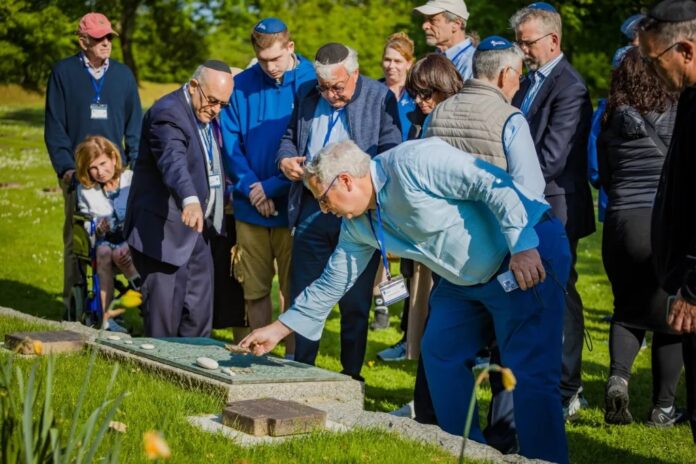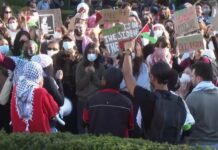
A Jewish-American hero of World War II who stormed Utah Beach on D-Day and disappeared after an ambush in the Battle of Cherbourg has been found in a German mass grave, buried alongside Nazis.
Nearly 80 years after his death on June 23, 1944, Lt. Nathan Baskind is set to receive a proper burial.
Baskind, the son of Lithuanian and Russian immigrants who settled in Pittsburgh and ran a wallpaper business, was drafted into the U.S. Army in 1942 at the age of 26, as documented by the Rauh Jewish Archives.
“He came from a successful family, he could have gotten out of [the war] if he wanted to,” said Shalom Lamm, co-founder of Operation Benjamin, a non-profit that identifies Jewish U.S. war veterans mistakenly buried under incorrect religious designations in American military cemeteries.
Baskind commanded four M-10 tank destroyers — modified Sherman tanks — in the US Army’s 899th Tank Destroyer Battalion during the fierce D-Day invasion.
After securing the beachhead, Allied forces aimed to capture the port city of Cherbourg, France.
As U.S. troops clashed with Nazi soldiers, who had orders from Adolf Hitler to defend the city at all costs, Baskind ventured behind enemy lines with only his driver on a reconnaissance mission.
They were ambushed.
Despite being “seriously wounded,” the driver managed to return to Allied lines and reported that Baskind had been struck by machine-gun and rifle fire and was presumed dead, according to Baskind’s personnel file at the National Archives.
US troops conducted an extensive search but found “no trace of Lt. Baskind or his vehicle,” the file states.
Listed as Missing in Action on July 13, 1944, Baskind was posthumously promoted from second to first lieutenant and awarded a Purple Heart.
Baskind’s name was added to the Wall of the Missing at the American Cemetery in Normandy, and his fate remained a mystery for nearly eight decades.
In 2022, a US genealogist visiting the German Marigny cemetery noticed a name on a plaque among 17 German soldiers that stood out — Baskind’s.
This prompted him to inform Operation Benjamin, and Lamm, along with his partner Rabbi Jacob J. Schacter, began their investigation.
The sleuths concluded it could be the long-lost lieutenant, and their senior genealogist, Rachel Silverman, contacted the German War Graves Commission, known as the Volksbund.
Digging through their archives, the Volksbund uncovered detailed documents that revealed Baskind’s fate.
After being captured and shot, Baskind was taken to a decrepit Luftwaffe hospital in Cherbourg, notorious for its “cesspool” conditions.
He died the night of his capture.
His remains were placed in a mass grave with 24 German soldiers in the hospital’s courtyard.
In 1957, this mass grave was unearthed, and the remains were reinterred in another mass grave 50 miles away at the German Marigny cemetery.
It is there, under three Gothic crosses, that Baskind’s remains were buried with 52 Nazi soldiers.
German officials found Baskind’s dog tag, a patch from the 899th Tank Destroyer Battalion, and lieutenant’s bars.
They informed the US Army, which twice failed to identify the remains.
Baskind’s family was told his body was “unrecoverable” — but were never informed of the Nazi grave.
“You have a Jewish kid from Pittsburgh buried with these enemy soldiers,” Lamm emotionally told The Post.
Lamm and Rabbi Schacter, a Yeshiva University professor, were committed to retrieving Baskind’s remains and returning him to his “family, his people, and his country.”
Operation Benjamin organized a visit to the mass grave where Baskind was buried — the first Jewish visit in 79 years.
At the gravesite, they recited the mourner’s kaddish and other traditional Jewish prayers.
“We are family, we are brothers, we are sisters,” Rabbi Schacter said in an emotional eulogy at the grave.
“We will never forget you.”
Baskind was the son of Lithuanian and Russian immigrants who settled in Pittsburgh.
“Everybody cried, everybody,” Lamm recalled.
“It was a magical, very sad, very emotional moment.”
Before the trip, Lamm sought the blessing of Lt. Baskind’s great-niece, Samantha Baskind, a professor of art history and Holocaust studies at Cleveland State University.
She made one request: “Would you put a stone there for me?” she asked.
This traditional Jewish gesture of placing a stone at a grave, which the Talmud says helps “keep a soul down in this world,” had significant implications.
In a meeting with German Brigadier Gen. Dirk Backen, Lamm played a video of Baskind’s great-niece urging him to allow Operation Benjamin to exhume the body.
“Knowing that he’s been buried in a German cemetery, so far from home and under a cross, is a jagged scar for my family,” Professor Baskind said.
Since the Germans wanted to identify another soldier’s remains in the same mass grave, they finally granted permission to exhume.
“The coincidence was amazing,” Lamm noted.
The exhumation, carried out over three days from Dec. 18 to 20, involved a team of 17 experts, including French and German anthropologists and University of Wisconsin specialists.
“I felt terrified,” Lamm admitted.
“It’s great to talk about it in theory but what if we’re wrong? What if we can’t find him? This is our one and only shot.”
The odds of finding Baskind’s remains were slim.
“We were exhausted, out of our minds,” Lamm recalled.
“The grave was soaked in water, and the soil was in terrible condition. The anthropologists doubted we’d find anything.”
“Our chances of success seemed to diminish at every step. It was looking very bleak.”
After retrieving numerous bones and separating potential matches for DNA testing, the remaining remains had to be reburied.
A German official asked Lamm, an Orthodox Jew, to lead the reburial service for the 52 German soldiers.
“I had a moment of panic,” Lamm confessed.
“You can’t make up a more surreal circumstance.”
In his speech at the grave, Lamm cited the Jewish custom of spilling drops of wine on Passover to symbolize not exalting in enemies’ demise.
“You are those drops of wine,” Lamm said about the fallen Germans.
Four weeks later, the moment of truth arrived.
DNA results confirmed a 99.989% match with samples from Baskind’s surviving family members.
After 79 years, Lt. Baskind was finally found.
“The match was spectacular — that was the hand of God,” Lamm said.
“The recovery of my great uncle… is almost surreal… it brings a measure of long-awaited solace to my family,” Professor Baskind stated.
Professor Baskind formally received her great-uncle’s Purple Heart from the Defense POW/MIA Accounting Agency on May 22.
The German Army handed over Lt. Baskind’s remains to the US Army in a ceremony at Ramstein Air Force Base on May 28.
On June 23, the 80th anniversary of his death, Baskind will be buried at the American cemetery in Normandy with full military honors in a Jewish ceremony presided over by Rabbi Schacter.
{Matzav.com}












The stones on a matzayva show that people visites.
The stones were placed by the people who just visited. Not many stones at all.